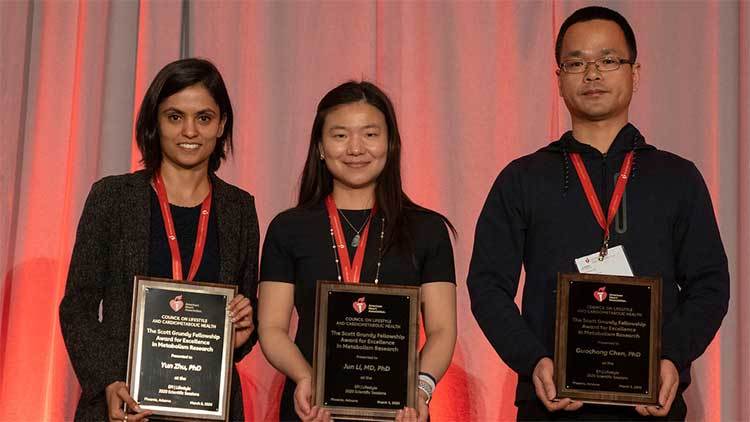Science News from EPI|Lifestyle 2020
Phoenix, Arizona
Tuesday's selected science
Tackling the AHA 2030 Impact Goal at EPI Lifestyle 2020
AHA president Bob Harrington, MD discusses the importance of the AHA 2030 Impact Goals at the meeting with Veronique Roger, MD, MPH, chair of the council on Epidemiology and Prevention and Penny Kris-Etherton, PhD, RD, chair of the council on Lifestyle and Cardiometabolic Health./p>
More Tuesday science
Effect of Estradiol Therapy on Arterial Wall Echomorphology in the Early versus Late Intervention Trial With Estradiol(elite)
Roksana Karim | University of Southern California, Los Angeles, CA
- AHA press release: Starting estradiol therapy soon after menopause may benefit arteries
- AHA News story: Estrogen therapy in early menopause may help keep arteries clear
Wednesday's selected science

#EPILifestyle20 Presidential Address
At the opening session, AHA President Bob Harrington, MD challenged attendees to reverse negative trends and build cultures of health. The AHA’s 2030 Impact Goal nearly doubles the forecasted improvement in healthy life expectancy. Achieving it requires addressing economic stability, affordable access to quality healthcare, social stability, infrastructure, and educational achievement. "Each of us can volunteer," Dr. Harrington said. "I'd encourage all of us to get involved."
EPI|Lifestyle Program Co-Chair Kristie Lancaster, PhD, RD interviews Matthew Gillman, MD, SM and Rebecca Gottesman, MD, MPH about their efforts to identify lifestyle factors throughout the life course that contribute to longer, healthier lives. Both speakers were featured in the opening session Wednesday at AHA's EPI|Lifestyle 2020 in Phoenix.
Retinal Microvascular Signs and White Matter MRI Findings: The Atherosclerosis Risk in Communities Neurocognitive Study
Jennifer A Deal | Johns Hopkins University, Baltimore, MD
- RESULTS: Fundus photography of microvascular retinal signs in adults 50–72 years of age were predictive of white matter (WM) disease and lacunar infarcts (substrates for dementia) seen on MRI 18 years later.
- Deal's Abstract in Circulation
Serum Metabolomic Signatures of Multiple Healthful Dietary Patterns and Incident Cardiometabolic Diseases in US Hispanics/Latinos
Guochong Chen | Albert Einstein College of Medicine, Bronx, NY
- RESULTS: Hispanic Community Health Study/Study of Latinos results: metabolomic signatures of 3 healthy diet patterns may help to explain the mechanisms of diet and cardioprotection.
- Chen's Abstract in Circulation
Healthy Lifestyle Factors and Cardiovascular Disease Risk in a Prospective Cohort of Women With a History of Gestational Diabetes Mellitus
Frank Qian | Harvard School of Public Health, Boston, MA
- RESULTS: For women with a history of gestational diabetes, maintaining more healthy lifestyle factors was associated with reduced cardiovascular disease (CVD) risk, with the potential to avoid 62.5% of the CVD risk by maintaining ≥4 healthy lifestyle factors.
- Qian's Abstract in Circulation
Urine And Plasma Metabolome of Healthy Adults Consuming the Dietary Approaches to Stop Hypertension Diet: A Pilot Study
Shirin Pourafshar | University of Virginia, Charlottesville, VA
- RESULTS: Urine metabolites identified in a pilot study comparing the DASH diet to a control diet included some that may be associated with lower blood pressure; more research is needed.
- Pourafshar's Abstract in Circulation
Variation in NT-proBNP Levels After Bariatric Surgery and Its Association With Body Fat Percentage
Mariana Sbaraini Da Silva, Johns Hopkins University, Baltimore, MD
- RESULTS: Reduced adiposity was linked to increased NT-proBNP levels and was independent of metabolic risk factor changes after bariatric surgery. More research is needed to understand these mechanisms.
- da Silva's Abstract in Circulation
More Wednesday science
Diana Baptiste | Johns Hopkins School of Nursing, Baltimore, MD
- AHA press release: Heart disease risk profiles differ widely among African Americans, blacks from the Caribbean and African immigrants
Thursday's selected science
Elizabeth Selvin, PhD, MPH interviews Paul Munter, PhD about the role of real world data and industry collaboration at in his work at the University of Alabama at Birmingham.

Do the #ElbowBump
Attendees demonstrate the best way to greet a colleague or friend during flu season, and especially since CoVID-19 has been in the news.
Novel Plasma Lipids Predict Risk of Diabetes: A Longitudinal Lipidomics Study in American Indians
Yun Zhu, University of Florida, Gainesville, FL
- RESULTS: In a study of American Indians from the Strong Heart Family Study, high-resolution lipidomics identified novel plasma lipids significantly predictive for T2DM onset in this high-risk population.
- Zhu's Abstract in Circulation
Comparative Effectiveness of Implementation Strategies on Cardiovascular Risk Factor Control in Patients With Diabetes: The D4C Cluster Randomized Trial
Jiang He | Tulane University, New Orleans, LA
- RESULTS: Adding a guideline-based treatment protocol in clinical decision support systems to team-based decisions reduced diabetic patient CVD risk factors more than team-based care alone.
- He's D4C Abstract in Circulation
Matthew Allison, MD interviews Andrea LaCroix, PhD, MPH about the results of the OPACH study looking at the relationship between mortality and daily step activity in older women.

Early Career in action
Anna Askari speaks during Session 06EC: Early Career 3-Minute Rapid Fire Oral Abstract Competition.
Steps-per-day And Cardiovascular Disease Mortality In Older Women: The OPACH Study
Andrea Z. LaCroix | University of California at San Diego, San Diego, CA
- RESULTS: In this group of women (average age 79 years), CVD mortality decreased with more steps per day even at levels lower than the often used 10K steps/day, suggesting age-specific steps/day recommendations could help to promote CV health. LaCroix's Abstract in Circulation AHA press release: More steps-per-day linked to significant reductions in diabetes and high blood pressure En español: Más pasos por día se relaciona con reducciones significativas de la diabetes y la hipertensión arterial
Stamler Award Finalists

Associations of Gestational Cardiovascular Health With Pregnancy Outcomes: The Hyperglycemia and Adverse Pregnancy Outcome Study
|

Association of Carotid Intima-Media Thickness and Other Carotid Ultrasound Features With Incident Dementia in The Atherosclerosis Risk in Communities
|

WINNER
|

The Role of Sleep as a Cardiovascular Health Metric: Does It Improve Cardiovascular Disease Risk Prediction? Results From The Multi-Ethnic Study of Atherosclerosis
|

Healthy Eating Patterns and Risk of Cardiovascular Disease: Results From Three Large Prospective Cohort Studies
|

Lactation Duration is Associated With Lower Visceral and Pericardial Fat Volumes in Parous Women: 25-year Follow-up in the Cardia Study
|

Interplay Between Diet and Gut Microbiota, and Circulating Levels of Trimethylamine N-oxide: Findings From the Men’s Lifestyle Validation Study
|
More Thursday science
Olive Oil Consumption and Risk of Cardiovascular Disease
Marta Guasch | Harvard School of Public Health, Boston, MA
- AHA press release: Consuming more olive oil associated with less heart disease in Americans
- AHA news story: Olive oil may lower heart disease risk
AHA press release: Eating more plant protein and dairy instead of red meat may improve heart health
En español: Comer más proteína vegetal y lácteos en lugar de carne roja puede mejorar la salud del corazón
Friday's selected science
Donna Arnett, PhD, MPH, past president of the American Heart Association, interviews Donald Lloyd-Jones, MD, ScM about his lecture, "Unraveling the Life Course of Cardiovascular Health: Determinants, Correlates, Mechanisms, and Outcomes." Dr. Lloyd Jones presented as the William B. Kannell Memorial Award Lecturer this year.
Josh Bundy, PhD, MPH, of Tulane University in New Orleans, discusses his presentation, "Estimated Impact of Achieving Optimal Cardiovascular Health in the US Adult Population on Cardiovascular Disease Events," which won the Jeremiah and Rose Stamler Research Award for New Investigators.

Awards presented at Joint Council dinner
Many attendees received awards and accolades for outstanding work over the past year during the Joint Council Dinner on Thursday evening.
Childhood Predictors of Type 2 Diabetes in Young Adulthood to Middle-age: The International Childhood Cardiovascular Cohort (i3c) Consortium
Tian Hu | University of Minnesota School of Public Health, Minneapolis, MN
- RESULTS: The International Childhood Cardiovascular Cohort (i3c) Consortium results: a childhood risk score model that included BMI, glucose and insulin was associated with adult T2DM.
- Hu's Abstract in Circulation
Aerial Drone versus Ground Search for Delivery of an Automated External Defibrillator (AED) for Out-of-hospital Cardiac Arrest: A Comparison of Elapsed Time and Bystander Experience in a Community Setting
Wayne D Rosamond | University of North Carolina, Chapel Hill, NC
- RESULTS: Delivery of an AED for OHCA by an aerial drone shows feasibility in the community setting - may get defibrillation to the patient earlier than bystander AED search.
- Rosamond's Abstract in Circulation
Addressing Cardiovascular Health Using Artificial Intelligence: Randomized Clinical Trial to Increase Physical Activity in Cancer Survivors Using Intelligent Voice Assist (Amazon Alexa) for Patient Coaching
Ahmed Hassoon | Johns Hopkins Bloomberg School of Medicine, Baltimore, MD
- RESULTS: On-demand AI coaching resulted in increased physical activity in obese or overweight cancer survivors.
- Hassoon's Abstract in Circulation
Sodium Sensitivity, Sodium Resistance, and Incidence of Hypertension
Jiang He, Tulane University, New Orleans, LA
- RESULTS: The risk for developing hypertension was increased with high sodium sensitivity or sodium resistance in this Chinese population.
- He's Sodium Abstract in Circulation